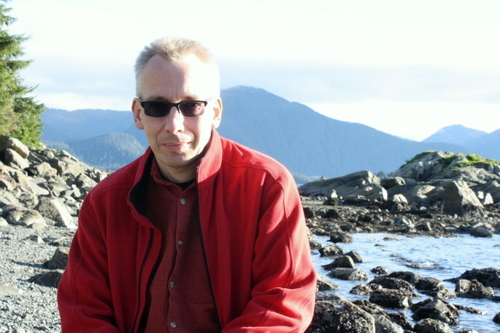
Bernhard Peucker-Ehrenbrink is a senior scientist at the Woods Hole Oceanographic Institution in Massachusetts. He’s spending the month of October in Sitka as part of a residency program for visiting researchers. (Photo by Ed Ronco/KCAW)
Bernhard Peucker-Ehrenbrink is a geochemist.
“Yeah, geochemistry,” he said during a recent interview. “The chemistry of the Earth: how the Earth has evolved and what the chemistry can tell us about that.”
Officially, he’s a senior scientist from the Department of Marine Chemistry and Geochemistry at the Woods Hole Oceanographic Institution in Massachusetts.
He studies rivers.
“I have been studying rivers for not quite a decade, and we’re now in the process of building what we call the global rivers observatory – a mechanism, a network, with partners worldwide to study the chemistry of rivers,” Peucker-Ehrenbrink said.
The project has looked at rivers around the world, including the Amazon, the Congo and the Fraser.
“I’m particularly interested in these small, steep drainage basins along the American west coast,” he said. “I was looking for good field sites to get a representative sample of rivers along the west coast.”
Sitka, as it turns out, has one of those: the Indian River.
“I’m hoping we can sample the river, maybe the Indian River for a year, and see how its chemistry changes – the nutrients, how the salmon habitat changes, and understand a little bit better how these small river basins change over the course of a year,” Peucker-Ehrenbrink said.
Sometimes river chemistry might be important to a few people in a localized place.
“People walk up to us and ask ‘Hey, is the water safe? Is it safe to drink? Can I swim in it? Can I eat the fish?'” he said. “And that’s related to the chemistry. You don’t want to have a polluted river right in front of your door step.”
And sometimes knowing river chemistry has worldwide implications, like when it comes to pollutants.
“There can be pollutants that come from far away – from China, for instance,” he said. “Contamination travels worldwide. There are so many aspects of that pollutant story.”
And right there, Peucker-Ehrenbrink used a word you don’t usually hear in science: “Story.”
“To me, (science) is all about story telling,” he said. “You have questions that you want to find answers for. When you find these answers, you have to present it in a way that other people can understand, because if you keep the knowledge to yourself you haven’t really contributed. You’ve only contributed when you tell these stories to the public, to other people who are not in the profession and make them appreciate it.”
Connecting the public with science – whether it’s by taking people out to a river to gather samples, or by giving a presentation in the classroom – is a huge part of the program that brought Peucker-Ehrenbrink to Sitka.
The program called the Science in Residency Fellowship, or SiRF. Sitka marine biologist Jan Straley wrote the proposal that created the program.
“It is an outcome of the Sitka WhaleFest scientists in the schools program,” she said. “We went to the teachers and said ‘What would you like? The scientists come for WhaleFest the week before and go into the schools. Would you like something in addition to that?’ And they said ‘Yes, we’d like more scientists at other times of the year. For longer, as well.’”
Peucker-Ehrenbrink is one of eight scientists spending a month each in Sitka during the first year of the program. The National Science Foundation funds the program at about $60,000 per year for three years, which covers travel, stipend, housing and all the logistics that come along with picking up your science career and moving it to Southeast Alaska for a month.
The idea, Straley says, is to give the scientists a sabbatical-type experience where they can get work done away from their daily routine. But they’ll also share their work with the community.
“People hear about science and it just seems so mysterious,” Straley said. “They don’t understand how a conclusion is drawn, or how a scientist comes up with an answer that seems pretty foreign or remote to an average person.”
But Straley says it doesn’t have to be that way. And Peucker-Ehrenbrink agrees.
“It’s fun to see that some of the science we do is fairly simple. The sampling – it’s all mechanical,” Peucker-Ehrenbrink said. “It doesn’t require any power tools. Only your hands, the original power tools. It’s quick, and I think it’s a good way to get people engaged in the research.”
Peucker-Ehrenbrink is involving the public in some of his field research. He’s in residence at the science center through the end of October.































